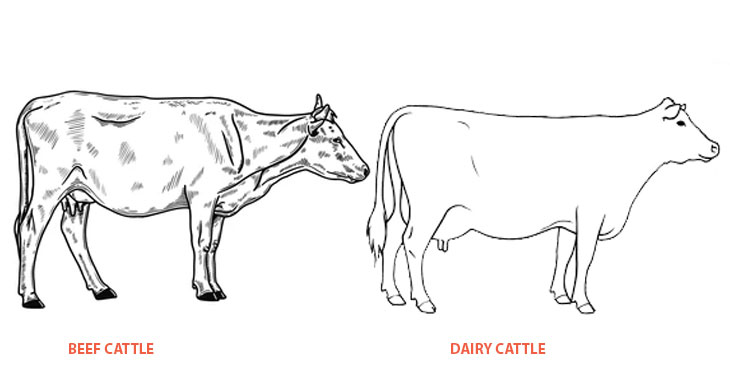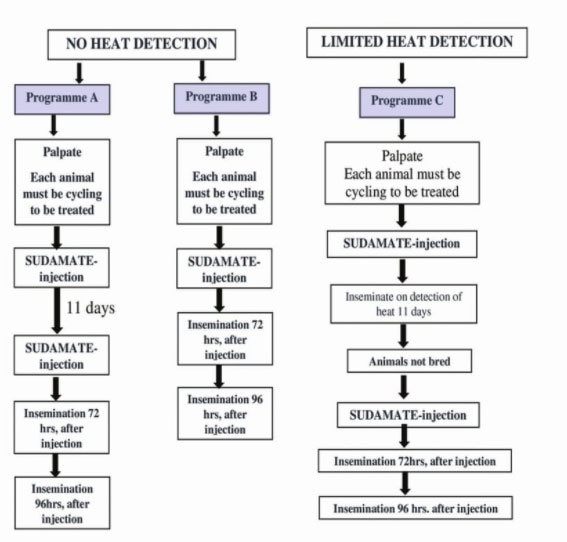Sudaprost

COMPOSITION :
- Each ml contains
- Active ingredient : Cloprostenol (as cloprostenol sodium) in an isotonic citrate buffer : 250 mcg
- Preservatives : 0.1% w/v chlorocresol B.P.
Usage:
Cloprostenol having ability to shorten the life span of the corpus luteum, can be used
- To treat certain clinical conditions which delay breeding.
- To manipulate the estrous cycle to better fit certain management practices.
- To induce abortion
Product Description:
Cloprostenol is a synthetic prostaglandin analogue, structurally related to prostaglandin F2 (PGF2).

Mechanism of action:
SUDAPROST causes functional and morphological regression of the corpus luteum in cattle. This effect on the life span of the C.L. usually results in estrus two to five days after treatment, followed by ovulation with normal fertility. SUDAPROST alone will not increase fertility.
Hypothalamic-Pituitary in the control of Female reproductive function
Oestrous cycle is regulated by the hypothalamic-pituitary-gonadal axis, which produces hormones. The reproductive axis is composed of the hypothalamus, pituitary, and the ovary.
The hypothalamus is a specialized portion of the ventral brain, its primary function is to release gonadotropin hormones (GnRH).GnRH stimulates the anterior pituitary gland to produce and release FSH (follicular-stimulating hormone) & LH (luteinizing hormone). FSH and LH are transported through systemic blood circulation to the ovaries, where they initiate a series of morphological changes that lead to ovulation and pregnancy if fertilization occurs.
The primary hormones produced by the ovary are estrogen and progesterone. These hormones are transported by the blood stream to "target" tissues to cause a reaction. Estrogen is produced by the follicle, which is located on the surface of ovary. As the follicle grows, more estrogen is produced. As increasing amounts of estrogen are released into the blood stream and travel to the anterior pituitary, it acts in a positive feedback fashion, stimulating pulsatile LH release.

It also affects the nervous system of the cow, causing restlessness and most importantly, the willingness to be mounted by other animals. Estrogen causes the uterus to contract, allowing sperm to be transported through the female reproductive tract more efficiently after insemination. Other effects of high estrogen concentrations in the blood include increased blood flow to the genital organs and the production of mucus by glands in the cervix and vagina. These characteristics are all signs of estrus, or sexual receptivity. Progesterone produced by the CL prevents cyclicity by acting on the anterior pituitary in a negative feedback fashion; therefore, decreasing the release of FSH and LH. It prepares the uterus for reception of fertilized ova and subsequent pregnancy. It also helps the cow maintain pregnancy by suppressing uterine contractions and promoting development of the uterine lining.
Last important hormone is prostaglandin F2a(PGF,) which is secreted by the endometrium of the uterus, it affects structures on the ovary, helping to initiate ovulation by causing the demise of the CL, which results in withdrawal of progesterone's negative feedback mechanism.
Indications:
- For Therapeutic Indications: Sub-estrus (silent heat or non-detected estrus), Pyometra or chronic endometritis: 2 ml/ animal.
- ForAbortion: Pregnancies from mis-mating and abortion in feedlot heifers & Mummified fetus: 1.5 ml/animal (2 ml for animal over 455 kg)
- For Controlled Breeding: 2 ml/animal


Following the controlled breeding program for animals those not conceiving, should be rebred. This may be done by :
- Observing animals for a return to estrus (especially during the third week after injection) and inseminating or hand mating animals returning to estrus
- Turning in clean-up bull(s) 7 to 8 days after the last injection to cover any animal returning to estrus.
- Many factors affect conception rates. Before a controlled breeding program is planned, the producer and his consulting veterinarian should review the operation's breeding history, herd health and nutritional status and agree that a controlled breeding program is practical in the producer's specific situation. For a successful controlled breeding program: Cows and heifers must be cycling. Cattle should be palpated.Cattle should be in good condition for breeding. Animals in poor or medium condition should be fed to ensure a positive nutritional balance for 4-6 weeks before SUDAPROST treatment and for 4 weeks after treatment.
- Proper program planning and record keeping are essential.
- Artificial insemination must be performed by competent inseminators using high quality semen. Inseminator fatigue must be avoided.
Contra-indications:
Since cloprostenol results in an abortion rate of approximately 95% in cattle up to 4 1/2 months of gestation and causes some cattle in later pregnancy to abort, it should not be given to pregnant animal unless induced abortion is desired.
Cautions:
To reduce the risk of anaerobic infections care should be taken to avoid injection through contaminated areas of skin. Clean and disinfect injection sites thoroughly before application.
Warnings:
Treated cattle must not be slaughtered for use in food for at least 48 hours after the latest treatment with this drug. No withholding time is required for milk when used according to the label.This product should be handled carefully to avoid accidental self-injection or contact with the skin or mucous membranes of the user. Prostaglandins of the F2a type may readily be absorbed through the skin and may cause bronchospasms and/or miscarriage.Pregnant women, women in childbearing age, asthmatics and people with other respiratory tract diseases should exercise extreme caution when handling this product such as wearing waterproof gloves.Accidental spillage on the skin should be washed off immediately with water. In case of accidental self-injection, seek medical advice and show the package insert to the doctor. Should respiratory distress result from accidental inhalation or injection, the inhalation of a rapidly acting bronchodilator is indicated. Keep out of reach of children.
Adverse Reactions
As with other products in this class, when used for induction of parturition, the incidence of retained placenta may be increased depending on the time of treatment. A low incidence of clostridial and other infections at the injection site has been reported following prostaglandin administration. Treated animals should be closely observed post injection and appropriate antibiotic therapy initiated at the first sign(s) of infection.Very rarely, anaphylactic reactions have occurred after administration of the product.
Overdose:
At 50 and 100 times the recommended dose of cloprostenol mild side effects may be detected. These include increased uneasiness, mild transient diarrhea, slight frothing, and milk letdown.
Storage:
Store at controlled room temperature 15-30 °C. Protect from light. Discard any remainder 28 days after initial broaching.
Pack:
20 ml, 50 ml and 100 ml.
